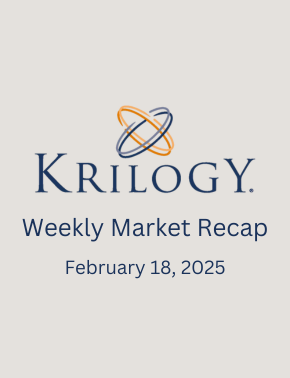Week in Review
Equity Markets:
The S&P 500 snapped a two-week skid last week and ended the week up 1.52%. The NASDAQ was the top-performing market, finishing up 2.6% as investors shifted to more risk-on positioning1. After two years, investors have favored “value” so far in 2025. The Russell 1000 Value Index is up 5.12% year-to-date, while its growth counterpart is lagging with a return of 3.76%1.
Earnings have come in well above expectations so far this quarter. The blended earnings growth rate currently stands at 16.9%2, well above the 12.6% growth rate estimate at the beginning of the quarter3. Earnings growth has been robust, but beat rates have come back to normal territory. Thus far, 77% of S&P 500 companies have reported earnings and 76% of companies have exceeded earnings estimates2. Revenue results also remain in line with historical averages, with 62% of companies exceeding analysts’ revenue expectations.
Fixed Income Markets:
The bond market was relatively uneventful last week, as yields stayed very flat. The 10-year Treasury yield fell a mere 0.02% lower to close the week at 4.47%. The small shift in the yield curve as parallel as the 2-year Treasury yield fell 0.03% and closed the week at 4.26%.
Despite the inflation misses last week the markets had already priced slower policy moves from the Fed. Over the past month, the Fed Fund’s Futures Market has priced in only one or two rate cuts in 20254. The market’s stance was confirmed by Chairman Powell’s testimony last week. He reiterated that policymakers are pleased with the progress already made to curb inflation but will need to see more confirmation before pursuing further rate cuts.
Economic:
Inflation reports last week confirmed recent concerns over inflation’s stickiness. The January CPI report showed a monthly increase of 0.5%, which equates to a 3% annual rate. The core reading, which excludes food and energy, rose 0.4% last month and 3.3% on a yearly basis. Both readings were above consensus estimates. The Producer Price Index, which has historically been a leading indicator of inflation, rose 0.4% in January, slightly above the consensus expectation of 0.3%. The consumer tightened spending following the holiday shopping season. Retail sales fell 0.9% last month, much worse than the 0.2% decline economists were expecting.
Looking Ahead
Equity Markets:
Earnings growth has started to outpace expectations, and if the trend continues this quarter, the S&P 500 will have its best quarter for earnings growth since Q4 20212. Earnings have also broadened and are not being dominated by a handful of companies in isolated sectors. 77% of the way through earnings announcements, Communication Services, and Financials are the leaders in earnings growth with growth rates of 32.2% and 30.8%, respectively5. Investors have rewarded strong earnings and valuations remain elevated. The forward four-quarter P/E Ratio sits at 22.6x, which still gives a reason for caution as we move through the year.
Valuations have been on the high end for some time now. While a 22 multiple on the S&P is elevated, it has yet to reach what we consider extreme. We believe investors should recognize that volatility and risk tend to come quickly. The major indices are all within 1% of all-time highs, and we believe it is prudent for investors to evaluate their current allocations to ensure they remain in line with long-term targets and desired risks.
Fixed Income Market
Our views and expectations for the fixed-income market remain unchanged despite the hotter-than-expected inflation reports released last week. Unlike in previous years, the market has not been at dramatic odds with policymakers. This has led to reduced volatility despite surprise reports. We agree with the majority in that we are likely to see a modest one or two cuts this year, barring a material breakdown in the labor market and/or economy.
We believe the 10-year yield will hover near 4.50%. If inflation reports continue to come in elevated, we see a scenario where the yield could briefly push toward the 5% level, but a move to that level will likely be short-lived. Given the income opportunity at current rate levels, we still have a positive outlook for fixed-income investors.
Economic:
The bulk of the economic reports this week will provide insight into the housing market. On Tuesday, the Housing Market Index followed by housing starts and existing home sales later in the week. Other notable reports will be The Conference Board’s Leading Economic Index and the final University of Michigan Consumer Sentiment Index. The headline event for the week will be the release of the most recent FOMC Meeting Minutes on Wednesday.
Sources:
1)JP Morgan
2) FactSet Research, Inc.
3)Yardeni Research, Inc.
https://yardeni.com/charts/yri-earnings-outlook/
4)CME Group
https://www.cmegroup.com/markets/interest-rates/cme-fedwatch-tool.html
5)LSEG I/B/E/S
https://lipperalpha.refinitiv.com/wp-content/uploads/2025/02/TRPR_82221_787.pdf
Important Disclosures:
Investment Advisory Services offered through Krilogy®, an SEC Registered Investment Advisor. Please review all prospectuses and Krilogy’s Form ADV 2A carefully prior to investing. This is neither an offer to sell nor a solicitation of an offer to buy the securities described herein. An offering is made only by a prospectus to individuals who meet minimum suitability requirements.
All expressions of opinion are subject to change. This information is distributed for educational purposes only, and it is not to be construed as an offer, solicitation, recommendation, or endorsement of any particular security, products, or services.
Diversification does not eliminate the risk of market loss. Investments involve risk and unless otherwise stated, are not guaranteed. Investors should understand the risks involved of owning investments, including interest rate risk, credit risk and market risk. Investment risks include loss of principal and fluctuating value. There is no guarantee an investing strategy will be successful. Past performance is not a guarantee of future results. Indices are not available for direct investment; therefore, their performance does not reflect the expenses associated with the management of an actual portfolio. The S&P data is provided by Standard & Poor’s Index Services Group.
Services and products offered through Krilogy® are not insured and may lose value. Be sure to first consult with a qualified financial advisor and/or tax professional before implementing any strategy discussed herein.




















